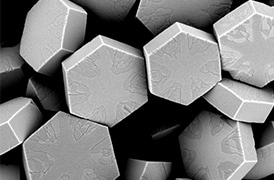Search Thermo Fisher Scientific
- Order Status
- Quick Order
-
Don't have an account ? Create Account
Search Thermo Fisher Scientific

Through the combination of atom-sized electron probes with high current and highly sensitive X-ray detectors, routine atomic-resolution spectroscopy is now possible with electron microscopes. Energy-dispersive X-ray spectroscopy (EDS, also abbreviated EDX or XEDS) can identify a wide range of elements due to their unique X-ray signals and is ideally suited for the differentiation of individual atoms. With this information, researchers can characterize and modify their materials at the atomic scale, providing unparalleled insight into the behavior of nanomaterials and particles.
As shown in the yttrium titanate examples on this page, individual atomic positions can be distinguished by their unambiguous chemical signal. The individual atomic columns are not only visible, but distinct from their neighbors due to their high contrast; even mixed and pure columns can be differentiated. Additionally, the EDS signal even makes it possible to detect light elements, which have been notoriously difficult to observe at these resolutions.
Such robust, high-quality results are only possible with Thermo Fisher Scientific’s unique ChemiSTEM Technology and the multi-SSD design of the Dual-X/Super-X Detection Systems. With both improved signal generation and detection, the low probe currents required for atomic-scale spatial resolution no longer pose a barrier to X-ray spectrum collection and analysis.
Novel materials are investigated at increasingly smaller scales for maximum control of their physical and chemical properties. Electron microscopy provides researchers with key insight into a wide variety of material characteristics at the micro- to nano-scale.

Battery development is enabled by multi-scale analysis with microCT, SEM and TEM, Raman spectroscopy, XPS, and digital 3D visualization and analysis. Learn how this approach provides the structural and chemical information needed to build better batteries.

As the demand for oil and gas continues, there is an ongoing need for efficient and effective extraction of hydrocarbons. Thermo Fisher Scientific offers a range of microscopy and spectroscopy solutions for a variety of petroleum science applications.

Effective production of metals requires precise control of inclusions and precipitates. Our automated tools can perform a variety of tasks critical for metal analysis including; nanoparticle counting, EDS chemical analysis and TEM sample preparation.

Materials have fundamentally different properties at the nanoscale than at the macroscale. To study them, S/TEM instrumentation can be combined with energy dispersive X-ray spectroscopy to obtain nanometer, or even sub-nanometer, resolution data.

Polymer microstructure dictates the material’s bulk characteristics and performance. Electron microscopy enables comprehensive microscale analysis of polymer morphology and composition for R&D and quality control applications.

Geoscience relies on consistent and accurate multi-scale observation of features within rock samples. SEM-EDS, combined with automation software, enables direct, large-scale analysis of texture and mineral composition for petrology and mineralogy research.

Every component in a modern vehicle is designed for safety, efficiency, and performance. Detailed characterization of automotive materials with electron microscopy and spectroscopy informs critical process decisions, product improvements, and new materials.

Catalysts are critical for a majority of modern industrial processes. Their efficiency depends on the microscopic composition and morphology of the catalytic particles; EM with EDS is ideally suited for studying these properties.
To ensure optimal system performance, we provide you access to a world-class network of field service experts, technical support, and certified spare parts.

